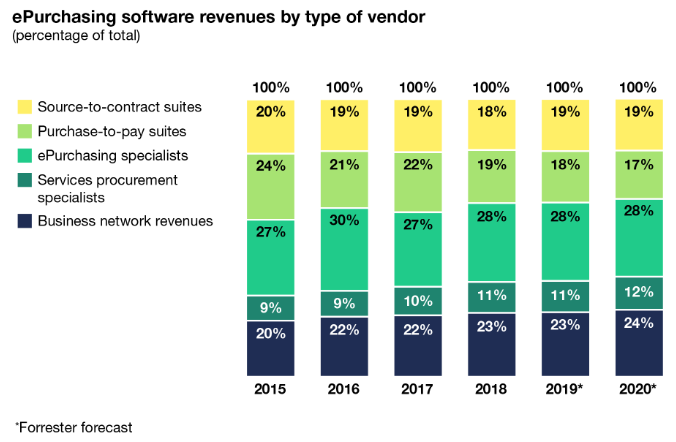In The Fast-Growing ePurchasing Software Market, Best-Of-Breed Apps Hold Their Own Against Suites
Which is the right choice: best-of-breed apps or application suites? This is a perennial question CIOs and business partners face in selecting application software. Forrester’s data on the ePurchasing software market — software that helps firms choose, contract with, buy from, and manage suppliers — shows that both options remain competitive. Indeed, it may well be that the attractiveness of both options to different audiences has helped the ePurchasing market achieve its growth of 12% to 15% in 2019 and 2020. (See “The ePurchasing Market Is Growing Almost Twice As Fast As The Overall Software Market — Specialists Are Holding Their Own Against Suites” Forrester report.)

Drawing actual and estimated revenues from over 100 ePurchasing vendors, we have been slicing and dicing this data to gain insight into the trends, patterns, and changing characteristics of this application market. Here are the key findings of this report:
- Overall demand remains strong. After growing at rates of 7% to 9% in 2016 and 2017, growth has accelerated to 12% in 2018 and 2019 and to 16% in 2020. It is likely that slowing economic growth and increased uncertainty are causing firms to give priority to a software category that can help them cut costs and better manage supplier risks.
- Cloud is taking over. Software-as-a-service (SaaS) subscription revenues and single-instance hosted revenues will represent over three-quarters of all vendor revenues.
- Services procurement, contract lifecycle management (CLM), spend analytics, and business network services will have the strongest growth. These products — which are applications that complete core eProcurement, eSourcing, and eInvoicing software — will grow by around 20% in 2020. Supplier risk and performance management (SRPM) software, another complementary app, will grow more modestly, by 13%.
- Spending on eProcurement, eSourcing, and eInvoicing is starting to grow after several years of low single-digit growth. These are relatively mature, core transactional applications that have been in transition from on-premises software to SaaS. But SaaS adoption has now reached the point that subscription revenues are large enough and growing fast enough to push overall growth to 10% or so in 2020.
- Both overall and in specific product categories, suite vendors and specialist vendors have relatively stable market shares. Source-to-pay suites, which combine eSourcing, spend analytics, CLM, and SRPM, will continue to capture 19% of total ePurchasing revenues. Purchase-to-pay suites combining eProcurement and eInvoicing will see their market share shrink to 17%. Meanwhile, specialist products in each category will retain 28% of the overall market. Services procurement and business network services will expand their share as firms tackle the critical problems of trying to manage their services spending and to connect and collaborate with suppliers.
In addition to data on the overall ePurchasing market, the report also analyzes the dynamics of each of the seven products that make up the ePurchasing market.
